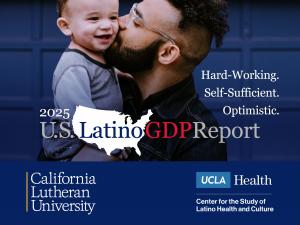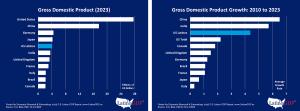
U.S. Latino GDP surges past $4 Trillion, larger than India’s GDP and faster growing than China’s
2025 U.S. Latino GDP Report: New data from leading researchers at UCLA and Cal Lutheran indicate that Latinos continue powering economic growth for the U.S.
THOUSAND OAKS, CA, UNITED STATES, April 10, 2025 /EINPresswire.com/ -- Reaching $4.1 trillion in 2023, the total economic output (GDP) of U.S. Latinos represents the fifth largest GDP in the world, larger than India’s and Great Britain’s. Since the start of the COVID-19 pandemic, the Latino GDP is the single fastest growing among major economies, growing even faster than China. The data, revealed in the 2025 U.S. Latino GDP Report, is being released at the California Hispanic Chambers of Commerce Business Policy Summit, in Sacramento on April 10. The report is the 8th annual in a series which documents the large and rapidly growing economic contribution of Latinos living in the United States.“Now surpassing the extraordinary milestone of four trillion dollars, the U.S. Latino GDP illustrates just how vital Latino strength and resilience are for the nation’s economy.” said Matthew Fienup, Executive Director of the Center for Economic Research & Forecasting at Cal Lutheran and coauthor of the report. “When COVID-19 struck, many analysts predicted that earlier Latino economic gains would be erased,” said David Hayes-Bautista, Distinguished Professor of Medicine at UCLA and coauthor of the report. “Despite being hit harder, the U.S. Latino GDP has roared back.”
Key findings:
• 2023 U.S. Latino GDP is $4.1 trillion, representing the fifth largest GDP in the world. Among the 10 largest GDPs, the U.S. Latino GDP is the third fastest growing, from 2010 to 2023.
• The performance of Latinos in the face of the pandemic, from 2019 to 2023, made the U.S. Latino GDP the single fastest growing among the ten largest GDPs, faster even than China.
The total economic output (or GDP) of Latinos living in the United States in 2023 is $4.1 trillion, up from $2.8 trillion in 2019 and $1.6 trillion in 2010. If Latinos living in the United States were an independent country, the U.S. Latino GDP would be the fifth largest GDP in the world, larger than the GDPs of India, the United Kingdom, or France. While impressive for its size, the U.S. Latino GDP is truly remarkable for its rapid growth. Among the ten largest GDPs, the U.S. Latino GDP is the third fastest growing from 2010 to 2023. The Latino GDP grew a remarkable 2.7 times faster than Non-Latino GDP over the entire period.
During the pandemic, COVID-19 spiked to become the number one cause of death for Latinos, whereas it was the number three cause of death for non-Latinos. From 2020 to 2023, the cumulative number of COVID deaths was nearly twice as high for Latinos (520 deaths per 1,000 Latino deaths) compared to Non-Hispanic Whites (only 263 per 1,000 Non-Latino deaths). Yet, the hard work and perseverance of Latinos in the face of COVID was sufficient to make the U.S. Latino GDP the single fastest growing among the ten largest GDPs, faster even than China. The broader U.S. economy ranks a distant fourth. Data reveal that Latinos were harder hit but recovered faster.
This year’s report once again documents the return of the Latino Health Advantage,” said Hayes-Bautista, “Which is one of the factors that drives the Latino GDP’s tremendous growth.” In 2023, COVID-deaths were no longer among the top-5 leading causes of death in the U.S., and COVID deaths are now lower for Latinos than Non-Latinos. Not surprisingly, the Latino life expectancy premium relative to non-Hispanic whites has nearly returned to the pre-Pandemic level of three years.
“Hard work, self-sufficiency, optimism, perseverence—these are the characteristics that underly the strength and resilience of U.S. Latinos,” said Fienup. “We believe these same characteristics will continue to drive growth in the overall United States economy for years to come.”
To download the full report, please visit: www.LatinoGDP.us. For questions about the report, please contact: Matthew Fienup (mfienup@callutheran.edu) and David Hayes-Bautista (dhayesb@ucla.edu).
Center for Economic Research & Forecasting (CERF)
CERF is a nationally recognized economic forecasting center. CERF economists Matthew Fienup and Dan Hamilton are members of the Wall Street Journal Economic Forecasting Survey, the National Association of Business Economics (NABE) Economic Outlook survey, and the Fannie Mae (formerly Case-Schiller) Home Price Expectations Survey. They were recipients of 2019, 2020, 2021 and 2024 Crystal Ball Awards for the Fannie Mae forecast survey. CERF is housed at California Lutheran University, a federally designated Hispanic Serving Institution.
Center for the Study of Latino Health & Culture (CESLAC)
Since 1992, CESLAC has provided cutting-edge research, education and public information about Latinos, their health and their impact on California’s economy and society. CESLAC is a resource for community members, business leaders and policy makers who want to gain insightful research and information about Latinos. It offers unparalleled insight into Latino issues through an approach that combines cultural research, demographic trends, and historical perspective.
History of the Latino GDP Project
The effort to calculate the Latino GDP began with David Hayes-Bautista in the early 2000s. His idea was to use established government data programs to calculate a robust summary statistic for the economic performance of U.S. Latinos. The original U.S. Latino GDP algorithm was developed by Hayes-Bautista with Werner Schink, former Chief Economist of the California EDD. They produced the inaugural U.S. Latino GDP Report in 2017. After Schink’s untimely passing, Hayes-Bautista sought out Cal Lutheran economists Dan Hamilton and Matthew Fienup. Hayes-Bautista, UCLA colleague Paul Hsu, Hamilton, and Fienup made refinements to the Latino GDP methodology and have produced annual Latino GDP Reports every year since 2019. With generous support from Bank of America, the Latino GDP Project was significantly expanded beginning in 2021 and now includes calculation of the Latino GDP for targeted states and major metropolitan areas as well as the inaugural U.S. Latina GDP Report, released in August 2024. For more information and to access reports, visit www.LatinaGDP.us and www.LatinoGDP.us
Matthew Fienup
Latino GDP Project
+1 805-493-3668
email us here
Distribution channels: Banking, Finance & Investment Industry, Business & Economy, Culture, Society & Lifestyle, Education, U.S. Politics
Legal Disclaimer:
EIN Presswire provides this news content "as is" without warranty of any kind. We do not accept any responsibility or liability for the accuracy, content, images, videos, licenses, completeness, legality, or reliability of the information contained in this article. If you have any complaints or copyright issues related to this article, kindly contact the author above.
Submit your press release


